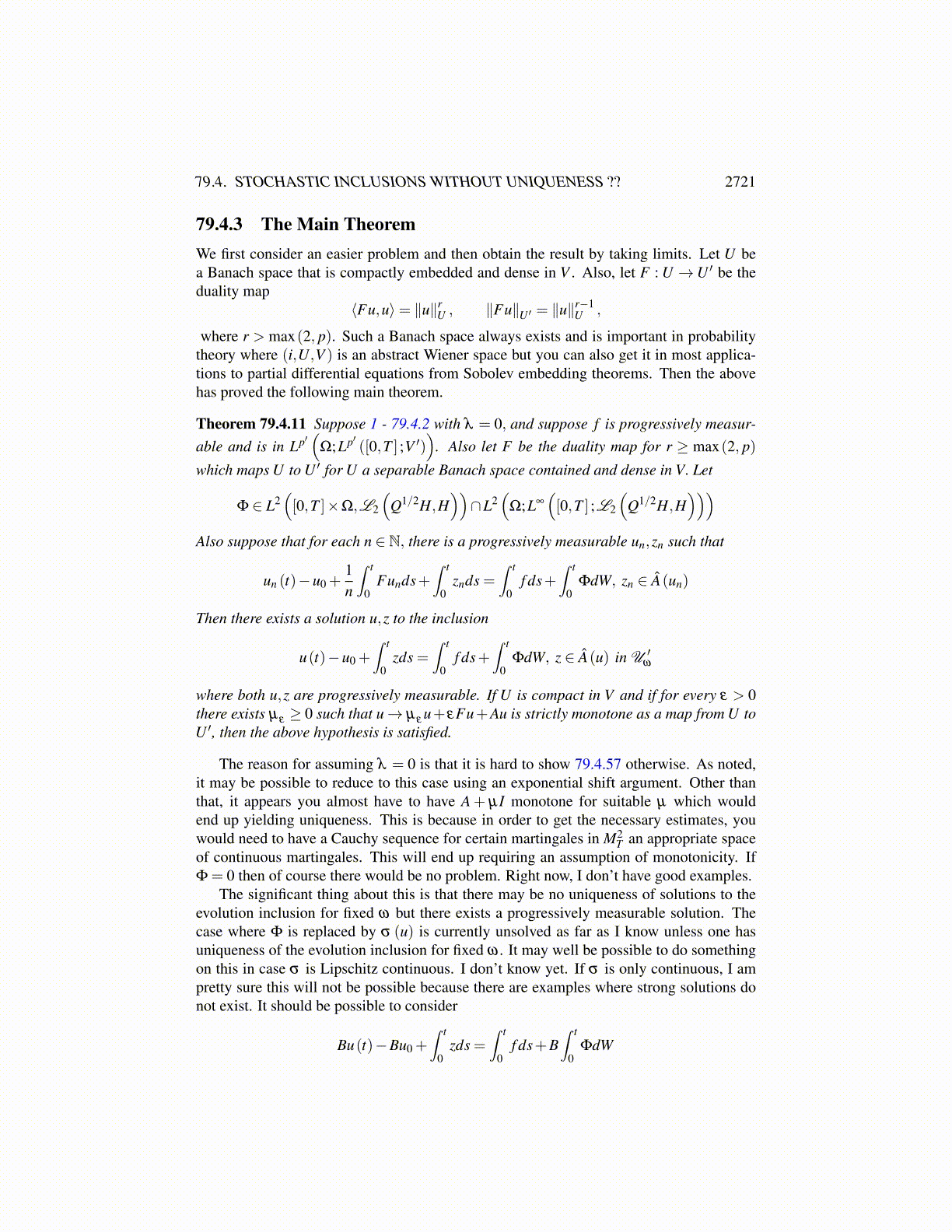
79.4. STOCHASTIC INCLUSIONS WITHOUT UNIQUENESS ?? 2721
which is P measurable. Thus G is a measurable multifunction.Since (t,ω)→ G(t,ω) is measurable, there is a sequence {wn (t,ω)} of measurable
functions such that ∪∞n=1wn (t,ω) equals
G(t,ω) =
{w : ⟨w,u(t,ω)− y(t,ω)⟩ ≤ α (t,ω)+
1n
, (t,ω) /∈ Σ
}∩B(0,γ)
As shown above, there exists wt,ω in A(u(t,ω) , t,ω) as well as G(t,ω) . Thus there isa sequence of wr (t,ω) converging to wt,ω . Of course r will need to depend on t,ω . Since(t,ω)→ A(u(t,ω) , t,ω) is a P measurable multifunction, it has a countable subset of Pmeasurable functions {zk (t,ω)} which is dense in A(u(t,ω) , t,ω). Let Uk be defined as
Uk (t,ω)≡ ∪mB(
zm (t,ω) ,1k
)⊆ A(u(t,ω) , t,ω)+B
(0,
2k
)Now define A1k = {(t,ω) : w1 (t,ω) ∈Uk (t,ω)} . Then let
A2k = {(t,ω) /∈ A1k : w2 (t,ω) ∈Uk (t,ω)}
andA3k =
{(t,ω) /∈ ∪2
i=1Aik : w3 (t,ω) ∈Uk (t,ω)}
and so forth. Any (t,ω) ∈ Sγ must be contained in one of these Ark for some r since if notso, there would not be a sequence wr (t,ω) converging to wt,ω ∈ A(u(t,ω) , t,ω). TheseArk partition Sγ \Σ and each is measurable since the {zk (t,ω)} are measurable. Let
ŵk (t,ω)≡∞
∑r=1
XArk (t,ω)wr (t,ω)
Thus ŵk (t,ω) is in Uk (t,ω) for all (t,ω) ∈ Sγ and equals exactly one of the wm (t,ω) ∈G(t,ω).
Also, by construction, the ŵk (·, ·) are bounded in L∞(Sγ ;V ′
). Therefore, there is a sub-
sequence of these, still called ŵk which converges weakly to a function w in L2(Sγ ;V ′
).
Thus w is a weak limit point of co(∪∞
j=kŵ j
)for each k. Therefore, in the open ball
B(w, 1
k
)⊆ L2
(Sγ ;V ′
)with respect to the strong topology, there is a convex combination
∑∞j=k c jkŵ j (the c jk add to 1 and only finitely many are nonzero) which converges strongly
in L2(Sγ ;V ′
). Since G(t,ω) is convex and closed, this convex combination is in G(t,ω).
Off a set of P measure zero, we can assume this convergence of ∑∞j=k c jkŵ j as k→ ∞
happens pointwise a.e. for a suitable subsequence. However,∞
∑j=k
c jkŵ j (t,ω) ∈Uk (t,ω)⊆ A(u(t,ω) , t,ω)+B(
0,2k
).
Thus w(t,ω) ∈ A(u(t,ω) , t,ω) a.e. (t,ω) because A(u(t,ω) , t,ω) is a closed set. Sincew is the pointwise limit of measurable functions off a set of measure zero, it can be as-sumed measurable and for a.e. (t,ω), w(t,ω) ∈ A(u(t,ω) , t,ω)∩G(t,ω). Now denotethis measurable function wn. Then
wn (t,ω) ∈ A(u(t,ω) , t,ω) ,⟨wn (t,ω) ,u(t,ω)− y(t,ω)⟩ ≤ α (t,ω)+1n
a.e. (t,ω)